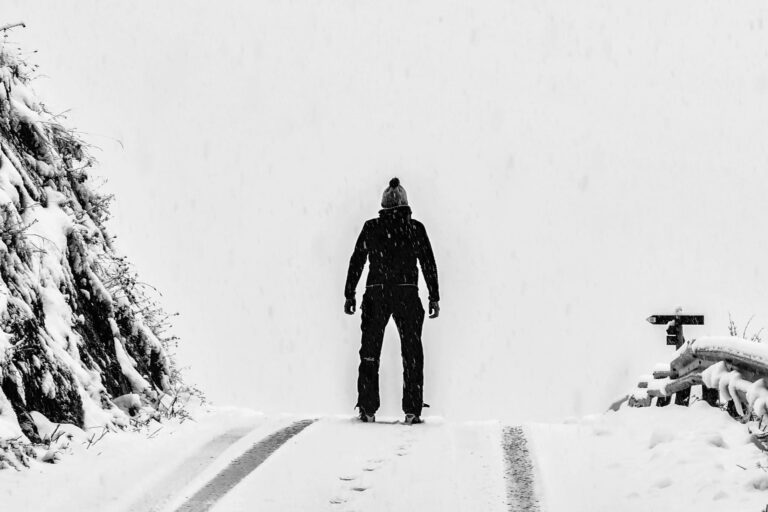Understanding Black Ice: At What Temperature Does It Form?

At what temperature does black ice form? Black ice- often a winter hazard, poses significant risks for drivers and pedestrians alike. A clear understanding of at what temperature does black ice forms and how to safely navigate it is crucial. This article will explore the formation of black ice, its dangers, the inadequacies of conventional methods, and the benefits of using modern solutions.
At What Temperature Does Black Ice Form?
Black ice typically forms when the air temperature is at or just below the freezing point of water, 0 degrees Celsius (32 degrees Fahrenheit). This often occurs when the ground temperature is cold enough to freeze the precipitation or dew, resulting in a thin, transparent layer of ice on roadways and sidewalks.
Why Is Black Ice Dangerous?
The danger of black ice lies in its transparency. It blends in with the road or sidewalk, making it nearly invisible to drivers and pedestrians. This can lead to unexpected slips and accidents, as it is difficult to detect until you are already on it.
Conditions Favoring Black Ice Formation
Black ice is most commonly formed:
- During Early Winter and Late Fall: When the ground is still cooling down.
- During Early Morning or Late Evening: When temperatures are typically the lowest.
- Following Rain or Snowfall: Especially if the skies clear and temperatures drop rapidly afterward.
Challenges In Walking On Ice And Snow
Walking on ice and snow, particularly on black ice, requires extra caution. The unpredictability and invisibility of black ice make walking on ice and snow treacherous, as individuals might not realize they are stepping onto a slick surface.
The Inefficacy Of Sand And Kitty Litter On Black Ice
While sand and kitty litter are commonly used for traction on ice, they are less effective on black ice. Sand can easily scatter away, and kitty litter may clump up when wet, creating a slippery surface. Neither substance alters the freezing temperature of water, so they do not prevent black ice from forming.
Get ready for winter with Walk On Ice instant traction on snow and ice
Walk On Ice: A Superior Solution
In contrast to sand and kitty litter, Walk On Ice is an effective solution for dealing with black ice. It provides instant traction on all icy surfaces, including black ice. When salt and ice melt fail or take time to work, leaving surfaces slippery, Walk On Ice offers an immediate solution.
How Walk On Ice Works
Walk On Ice works by absorbing the liquid layer of water on the ice, allowing its grippers to lock into the ice, thus creating a stable, non-skid surface. This makes it an ideal solution for walking on ice and snow, especially in conditions where black ice is present.
The Natural Benefits Of Walk On Ice
Walk On Ice is 100% natural, and safe for pets, people, and property. Its environmentally friendly nature makes it a responsible choice for winter safety. Unlike sand and kitty litter, Walk On Ice does not create messy conditions and is effective even in extreme cold, down to -35 degrees Celsius.
Where Does Black Ice Form Most Often?
And while understanding the temperature at which black ice forms is essential, it’s just one piece of the puzzle. The next question many people ask is, where does black ice form most often? It doesn’t appear everywhere equally. Bridges and overpasses are notorious because they’re exposed to cold air from above and below, cooling faster than surrounding roads. Shaded areas, like tree-lined streets or spots near tall buildings, also freeze more quickly because they don’t get direct sunlight to warm the pavement.
You’ll also find black ice forming in low-lying areas where water naturally drains and pools. Driveways, parking lots, and sidewalks near gutters are classic examples. Even if the rest of the street looks clear, these pockets can remain treacherous. The key is to remember that black ice doesn’t form evenly; it hides in specific zones where the conditions are just right.
Can Black Ice Form Without Rain?
One of the most surprising facts is that black ice can form without rain. Many people assume you need precipitation for ice to appear, but that isn’t always the case. If the ground is already cold and the air temperature drops overnight, moisture from dew or even fog can freeze into a thin, transparent sheet.
This makes early mornings especially dangerous. You might step outside thinking the pavement is just damp, when in reality, it’s covered in a nearly invisible layer of ice. Drivers heading to work at dawn or pedestrians walking their pets are often caught off guard in these conditions. That’s why tools like Walk On Ice can be so valuable—you don’t always see the hazard until you’re standing on it, but you can make surfaces safe instantly once you do.
Where Is Black Ice Often Found on Roads and Walkways?
So, where is black ice often found when you’re out driving or walking? Aside from the shaded and low-lying spots, black ice commonly shows up at intersections, entrance ramps, and spots where cars slow down or stop. That’s because vehicles compact snow, which then melts slightly under pressure and quickly refreezes when temperatures dip again.
On sidewalks, you’ll often notice black ice near the edges of buildings where melted snow drips from roofs and gutters. It also appears near driveways where shoveling piles up snow that later melts and refreezes. The pattern is simple: anywhere water can settle, you’re likely to find black ice once the temperature hits freezing or just below.
How to Drive on Black Ice Safely
Perhaps the most urgent question people ask is: how to drive on black ice without losing control? The most important rule is to stay calm. Overreacting—slamming on the brakes or jerking the steering wheel—can send your vehicle into a skid. Instead, ease off the accelerator and steer gently in the direction you want to go. If you need to brake, do so lightly and steadily, especially if your car has anti-lock brakes.
Speed is another factor. The slower you drive in icy conditions, the more time you have to react. Keep extra space between you and the car in front of you, since stopping distances increase dramatically on slick surfaces. And if you hit a patch of black ice while accelerating uphill, resist the temptation to press harder on the gas. Instead, maintain a steady speed and use traction aids if you lose grip. Keeping a canister of Walk On Ice in your trunk can save you from getting stranded on icy driveways or parking spots.
Conclusion
Understanding at what temperature black ice forms is only part of the puzzle. Equally important is knowing where black ice forms, realizing that black ice can form without rain, and remembering where black ice is often found in daily life. Add to that the skill of how to drive on black ice safely, and you have a much stronger toolkit for navigating winter hazards.
Traditional fixes like sand or kitty litter fall short, particularly against something as deceptive as black ice. Walk On Ice, however, gives you instant, reliable traction whether you’re walking on sidewalks, climbing icy steps, or trying to move your car. It’s natural, safe for pets and people, and designed specifically for the hidden dangers winter brings.
Black ice may be invisible, but your preparation doesn’t have to be. With knowledge, caution, and the right tools, you can face the season confidently—protecting yourself and your loved ones from slips, falls, and frustrating winter accidents.
Other Ice Melt Products
Safe Paw
The Original and #1 Selling Pet and Child Safe Ice Melt for over 20 years. Guaranteed environmentally safe – will not harm waterways and sensitive wetlands. All products are made in the USA.

Safe Thaw
Imagine an ice melt you can put down and never worry about. It won’t harm pets, kids, and your property. That’s Safe Thaw. Unlike anything else on the market, Safe Thaw can change how winter affects our planet.



